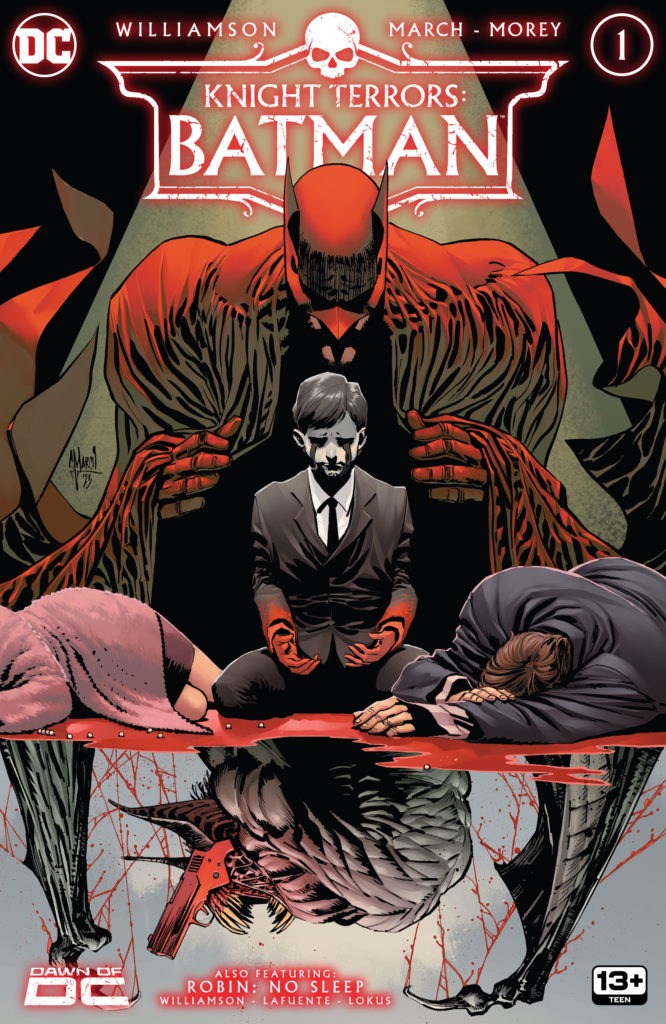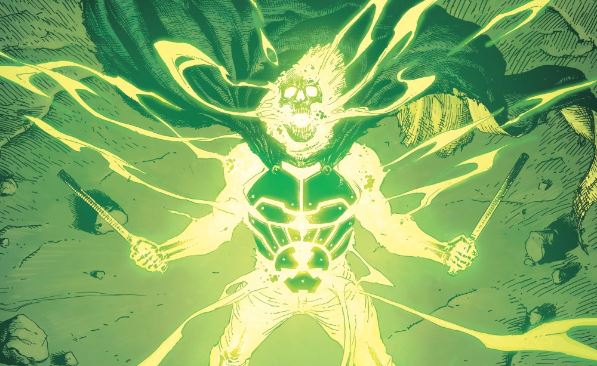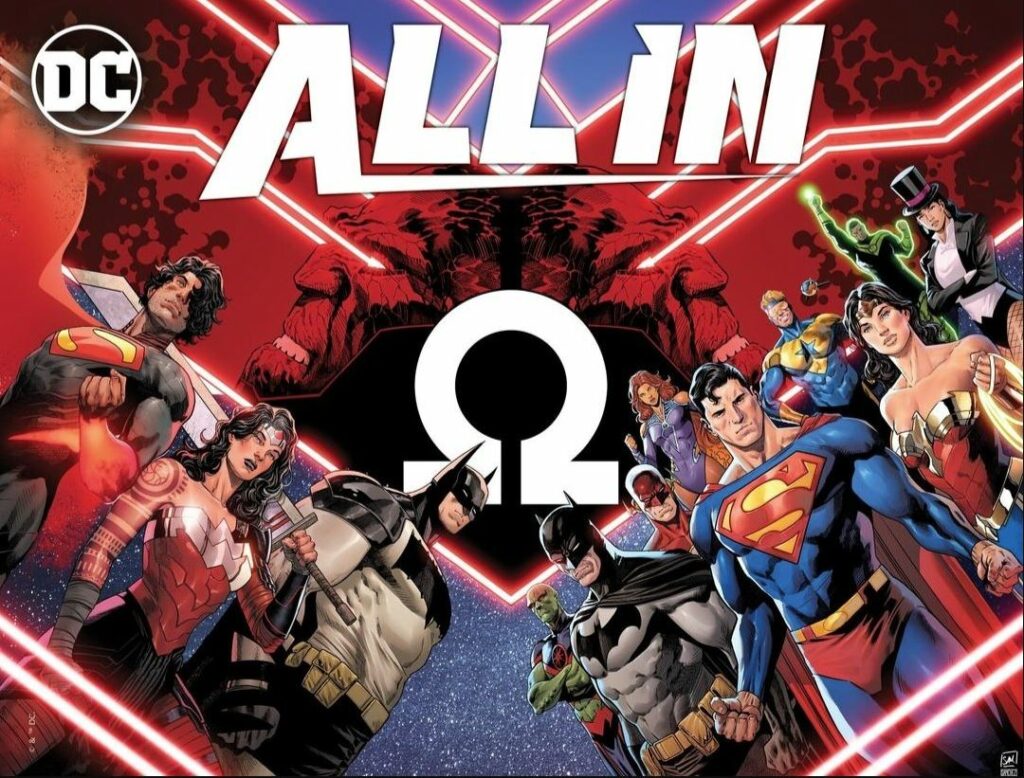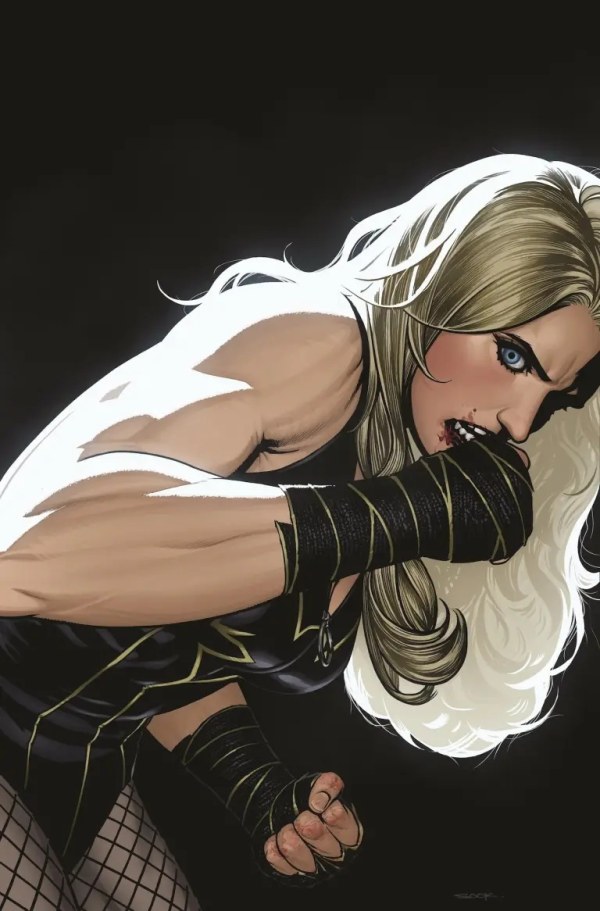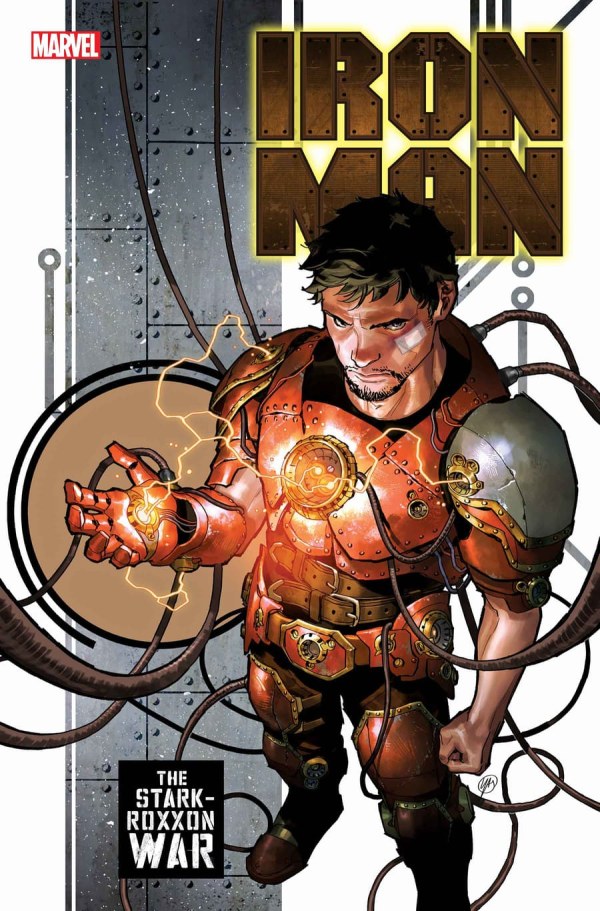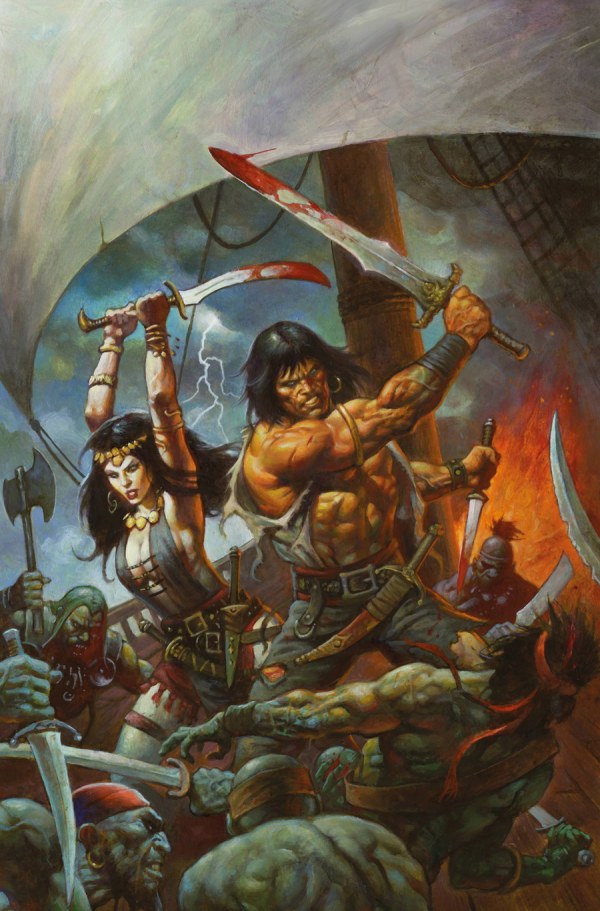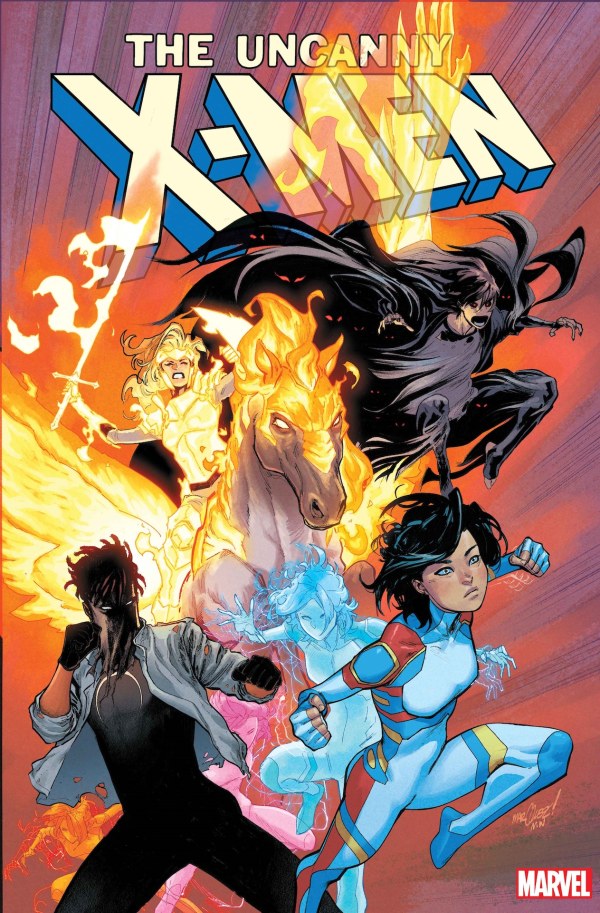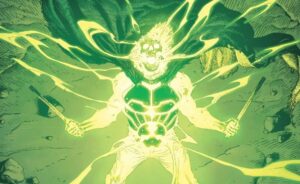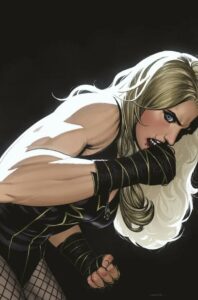Picking up right where Knight Terrors: First Blood #1 left off, Knight Terrors: Batman #1 continues the spooky romp into the psychology of the DC Universe in gothic style.
What’s more, it manages to elevate a fun yet otherwise flimsy opening issue by injecting a sustained focus on character that engages (even if not entirely successfully) with the cyclical nature of comics, and event comics specifically.
Setting the Stage for (Knight) Terrors
Following on from the cliffhanger at the close of First Blood, this issue, along with the rest of this week’s releases, provide some much-needed depth to proceedings. As is the case for all heroes and villains involved in Knight Terrors, Batman finds himself trapped inside his own mind, battling his worst nightmares.
Something that benefits Knight Terrors: Batman #1 is how keen it is to establish the parameters of the conflict. Superheroes, Batman in particular, are no strangers to hallucinatory fights with their darkest fears made manifest – and Williamson knows this. ‘You need to get some new tricks,’ Batman taunts at Insomnia, aware of how tropish the device is becoming.
What’s different about it this go around though is the power dynamics. It’s not Insomnia launching a barrage of fears at Batman; it’s Batman’s own subconscious mind working against itself, with Insomnia bereft of control.
Functionally, this might not seem like much of a distinction – Batman’s still fighting apparitions of the mind, as he would in any Scarecrow story, for example. However, this change does position a couple of things in Knight Terrors: Batman #1 in interesting ways.
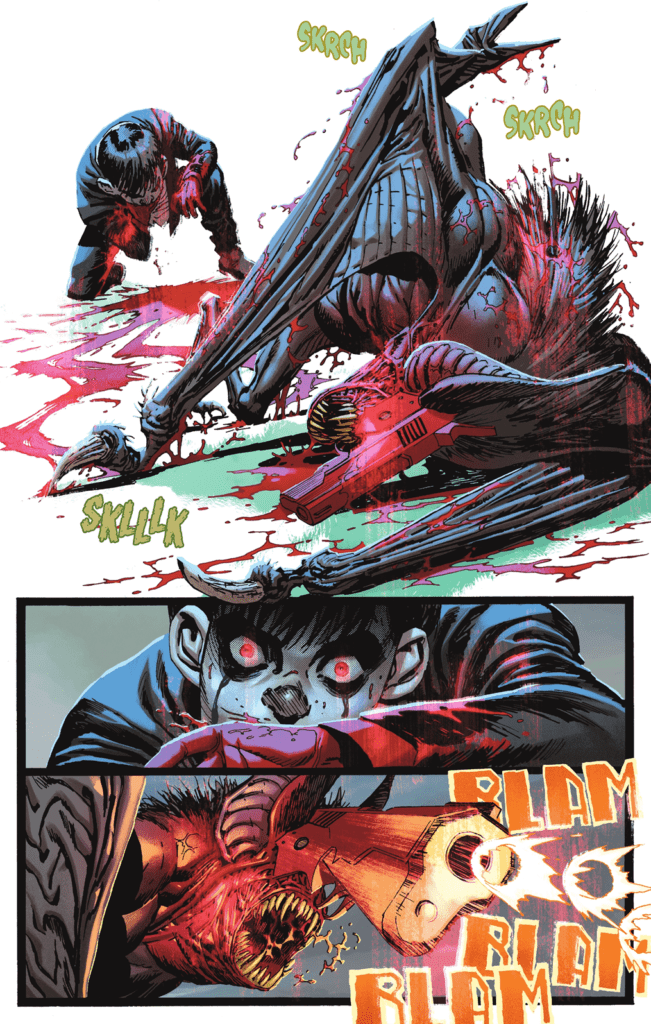
First, it allows Insomnia to step back from such an actively antagonistic role, and become more of an observer. He serves as a kind of cracked-mirror foil for the audience, sitting beside us, enraptured by the psychological turmoil Bruce is in as much as we are while also remaining separate. It expands on something that really worked in First Blood, which is that Insomnia, as a villain, isn’t inherently out to ruin everyone’s day – he just happens to need to in order to achieve his goals. It’s a small layer of depth, but it’s appreciated nonetheless, as it helps distinguish him from every other cackling maniac to grace Gotham’s streets.
Second, it makes things far more personal for Batman. As Williamson himself points out, Bruce has been through so many fear-assaults that facing another wouldn’t reveal anything new, nor would it unnerve him in any particularly innovative way. Should the psychological threat come from himself however, that changes things.
Knight Terrors: Batman #1 deftly plays out and dismisses the usual suspects for Bruce’s greatest fears: dead Robins, a loveless Catwoman, broken pearls in a dark alley, even the very concept of happiness. With that breathing room it digs deeper, turns more introspective. What if Bruce’s nightmare isn’t tied to him, but originates from him? What if the forever-mission of striking fear into the hearts and minds of a superstitious and cowardly lot is more monster than human? If his legacy is one of nightmares, how does that instil hope?
What if, because it’s cool as hell, that nightmare manifests as a giant bat with a gun for a face, that Bruce vomits out in a graveyard? It raises some interesting questions about how an aging Bruce sees himself, and his legacy, while never losing sight of the wild, escapist fun that a summer event should be.
If issue #2 can maintain this level of character study, mixed with only-in-comics action and unsettling body horror, then it will likely become one of the most conceptually memorable of all the tie-ins.
Horror, Intentional and Otherwise
When it comes to the level-of-the-page craft on display, I’m torn.
On the one hand, Guillem March delivers an absolute masterclass in marrying creepy body horror with superheroics and psychological introspection. The emergence of what I’ll be heretofore referring to as the Gun-Bat is a thing of horrific beauty, as Bruce (in his child body) vomit-births this monstrosity into his own dream.
It’s the kind of design that shouldn’t work, but given the waking dream quality of the story, and the phenomenal rendering of its physicality, it succeeds in a way that you can only achieve in comics. It’s bizarre, and creepy and a little bit ridiculous (but no more so than a billionaire that dresses up as a bat to fight crime), and it’s that confluence of reactions that it stirs that makes it feel so natural within the internal logic of the story.
Also of note in Knight Terrors: Batman #1 is how well composed March’s pages are.
There are the obvious examples, like the page shown in the section above, that manages not only to weave in a great sense of rhythm – that 3-beat layout always so effective at creating a feeling of set-up, tension, explosion that brings you into the page – but also in how it plays with panel size to vary the time the reader spends per image, orchestrating one’s experience even further.
Then there are examples like the two pages shown below.
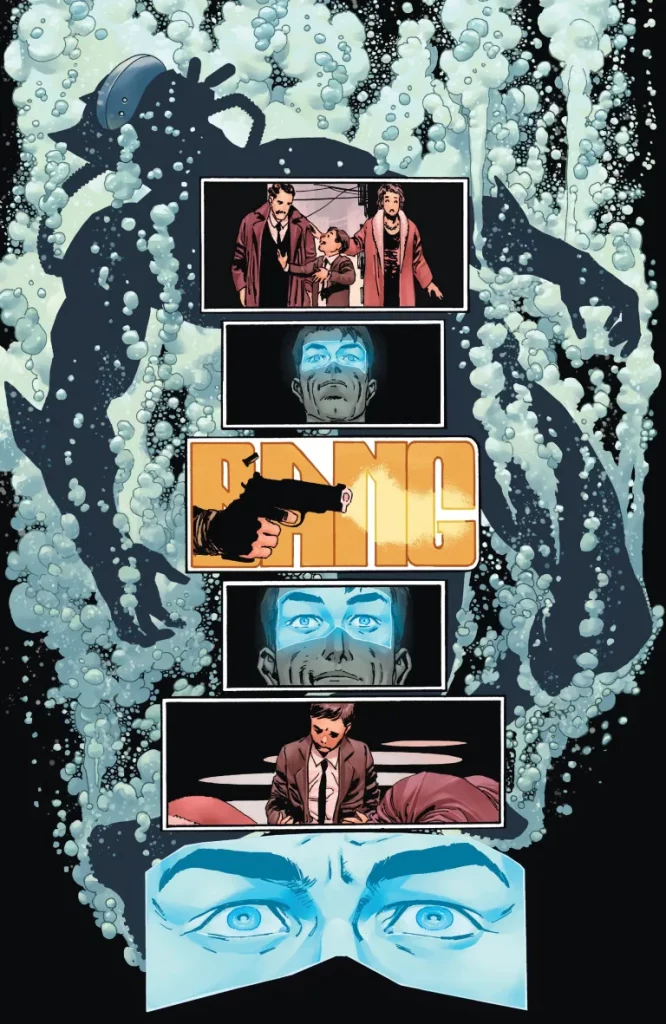
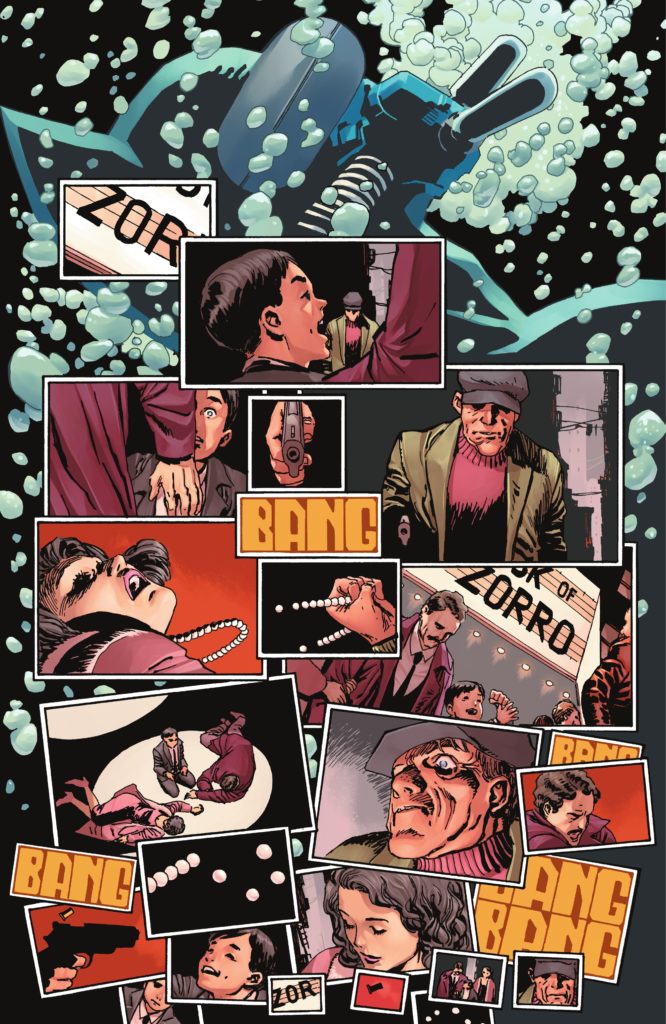
The contrast from one page to the next is striking. Bruce submerges himself in a nightmare machine, at first in control, his thoughts structured, ordered, linear. He’s being subjected to the worst day of his life, but the reader is shown Bruce’s face interjected throughout. He’s present, emotionally and visually. Moreover, he’s an observer just like us – the focus on his eyes implying that distance that exists between us and the page similarly exists between him and this experience. Batman is safe.
Juxtaposed against that is the page turn.
Immediately, Bruce loses control. His thoughts are jumbled, disordered. There’s no temporal hierarchy, and the traumatic content of his memories – the sounds of gunshots, the splaying of the pearls – lose their context. They’re no longer images to be observed, they’re an assault. And, importantly, Bruce is nowhere to be found. No longer is he this distant observer, but rather his sense of self has been erased. It’s not even that he’s lost control – Bruce, as a concept, ceases to matter within the context of the scene. All that remains is the nightmare, smothering an unconscious Batman into the background of the page.
On the other hand, where the visual language of Knight Terrors: Batman #1 sings, the written language suffers. I’ve given credit to the ideas Williamson is employing, and I think they’re worthy of a reasonable amount of merit. Where he falls short is in his dialogue.
As is typical with bigger event-scale titles, Williamson leans in to a heavily Silver Age inspired tone and cadence for a lot of his dialogue. It focuses a lot on explanation, often through exclamation, and it gived the issue a very theatrical feel.
When done well, dialogue like this should read like passion being worn on a writer’s sleeve, as their scripts pay tribute to a bygone era of simpler, dramatic storytelling. Great examples of this include titles like Ant-Man: Ant-iversary by Al Ewing and Tom Reilly, which hops eras and replicates the trappings of each with immense care so as to pay tribute and build immersion without ever veering into the realm of parody (intentional or otherwise). Knight Terrors: Batman #1 is no such comic.
Instead of conveying a sense of wonder and awe through the characters’ reactions to events, evoking a halcyon time without getting lost in it, it just comes off awkward and at worst anachronistic.
Dialogue should always support the tone and movement of a plot, emphasising great characterisation in ways that Williamson is certainly capable of on titles like Green Arrow. Unfortunately, it feels like Williamson is giving subtext the silent treatment, as Bruce repeatedly explains events and his feelings out loud for Insomnia (but really the reader) to ensure no one ever has to worry that they haven’t caught what’s happening. One particular moment that struck me was when Bruce utters: ‘My mother’s pearls’. Without spoiling the context, all I’ll say is that it takes a visually arresting moment, filled with subtextual implications and reduces it to this unnecessary aside to the reader.
While the quality of the dialogue varies throughout, with some genuinely great scenes to balance out those described here, it is unfortunately a disappointing mark against an otherwise conceptually sound issue.
Is Knight Terrors: Batman #1 Backed Up by the Backup?
Recently, the backups that Chip Zdarsky has made use of in his ongoing Batman series have really impressed with how intentionally they contribute to and expand on the main narrative.
So, seeing this issue listed as having a Robin backup (drawn by the excellently cast David Lafuente) the question was obvious: would Knight Terrors: Batman #1 follow suit?
The answer: not really.
Much like its main story, this issue’s backup is brilliantly composed at a visual level, with Lafuente’s pencils being an excellent match for the tone of a Damian story. Of special note is how well he renders Damian’s facial expressions, really capturing the impetuousness of the youngest Robin, but also the competence and self-assuredness.
Unfortunately, it’s an 8-page story that exists simply to explain a plot point coming in a few weeks’ time when readers ask: “hold on, how comes Damian didn’t fall under Insomnia’s spell?”
Williamson’s dialogue actually improves greatly here, likely due to his love of Damian Wayne and the unspent energy he has for him since the sooner-than-planned ending of his Robin series. Yet, while the act of watching Damian go on his side quest is enjoyable, it’s ultimately not long enough to get into anything to substantial character-wise.
Waking Up from the Nightmare
Knight Terrors: Batman #1 is a flawed entry into an event that is off to a slightly weak start, but one that is so accomplished in its strongest areas that it successfully allays any fears one might have coming out of Knight Terrors: First Blood #1.
It demonstrates a strong conceptual grasp of the story at hand, making the most out of the limited page space it has. Williamson, March and Lafuente deliver a visually spectacular comic that, while not perfect, leave you with an overwhelming feeling of the rule-of-cool having won out.
Given this is DC’s summer event, I think that’s as good a metric for success as any.


